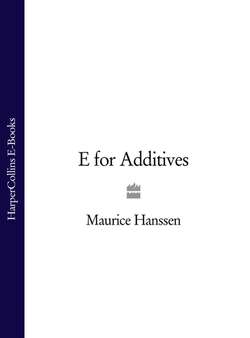Читать книгу E for Additives - Maurice Hanssen - Страница 8
Introduction
ОглавлениеMy first encounter with food additives was in the 1950s when I was concerned with creating new products for people on special diets. It soon became clear to me that many food technologists were using a wide variety of additives simply because they were available, and that they had not really given any thought to the nutritional or health consequences of what they were doing.
I asked the question: ‘Why are we using ingredients that I would not need in the kitchen when preparing the same food?’ Sometimes there were good technical reasons, but in 90 per cent of the cases there was none. It is because I enjoy cooking at home and because I have a strong background in practical food technology on a factory scale that I began to question whether or not we had true freedom of choice whether we knew what we were eating and whether many of the additives were necessary at all.
In the 1960s, with the National Association for Health, sponsored by Joyce Butler MP, and with the help of 750,000 well-wishers, we presented a petition to Parliament asking them to ‘add all additives’. This was a plea to have a full label declaration of all the ingredients.
For the past 100 or so years there has been an artificial division in our minds between foods and medicines. Since the earliest times man has known that he can live on a wide variety of foods, and that some apparently attractive plants are dangerous whilst some help bring vibrant health and fitness. Even more sophisticated has been the use of very small quantities of otherwise dangerous herbs, such as foxglove or deadly nightshade, which are both still today very important medicines in minute doses.
To stay at the peak of fitness a Roman soldier was only allowed stoneground wholemeal flour. None of the sifted white flour, beloved of the rulers of Rome, found its way into his diet. In the Middle Ages, writers on health said that ‘the bread which had all the bran in it was a remedy for constipation caused by eating too much of the fine white bread’! It is obvious that the foods we eat are more important than any additives. But in general terms we have had personal control over our choice of food but little influence on the additives being used.
The 1984 Food Labelling Regulations gave us, for the first time, a good insight into what we were eating and gave me the chance to write E for Additives. Even if the book had not sold a single copy I would have needed it for myself and my family. But in the event it was a bestseller which has prompted fundamental changes in the food that we buy. Almost overnight, crisp manufacturers found that they could remove E320 and E321. This may have reduced the shelf-life of the crisps but, with the odd exception of Scotland where apparently food takes a long time to be delivered, the additive-free crisps lasted quite long enough for any shop with a good turnover of stock. This story was repeated, with a wide range of unnecessary and, to some sensitive people, harmful additives, being removed.
A close and careful reading of The New E for Additives will show you that there are doubts about only 1 in 5 of the additives commonly used in British food. Some of these have been the most common but, fortunately, public pressure is reducing their usage. Toxicity is dose related and at some level of intake all foods are toxic We have to keep a balance, but we also have to ensure that we are not being misled with our senses distorted by the use of additives so that high fat and high sugar foods with a very low essential nutrient content give the feeling, appearance, and taste that they are good balanced nutrition. They may be, but an informed look at the label can in most cases give the true picture.
E for Additives provoked a huge correspondence from both consumers and manufacturers, a lot of which was extremely useful in preparing this new edition. It reflects the vast amount of new knowledge that has become available during the intervening three years and its purpose is to increase understanding and to encourage the enjoyment of good, well-prepared foods whether they be in the home, restaurant, health store, or supermarket.
